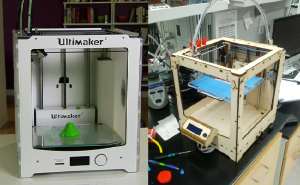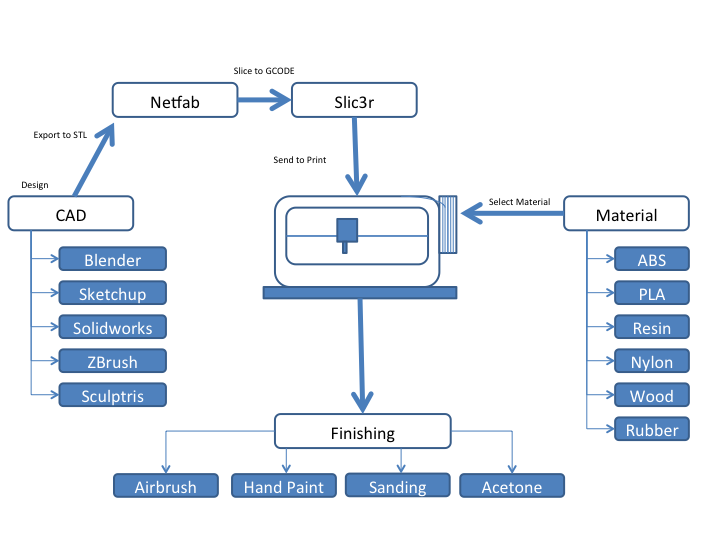Difference between revisions of "Equipment/Ultimakers"
(Created page with "{{EquipmentInfobox |name=Ultimakers 1 & 2<!-- Do not change! Takes name from the name of the wiki page it is on. --> |image=Ultimakers.png <!-- Image of the item. Leave with p...") |
(No difference)
|
Revision as of 14:21, 23 September 2015
| Ultimakers 1 & 2 | |
|---|---|
 | |
| Sub-category | CNC |
| Status | Good working order |
| Consumables | Printer filament |
| Training requirement | Yes |
| Training link | 3dprinter_training |
| ACnode | yes |
| Owner | Wevolver |
| Origin | Loan |
| Location | Robotics Area, basement |
| Maintainers | Rich, Tolland, Chris |
Description
ACNode is in operation on the Ultimaker-1, the ultimaker-2 is not yet commissioned. In order for your existing training to be approved on ACNode, you must run through a refresher session to ensure you are upto date (ACNode procedures, Octoprint procedures).
If you have been trained previously and need approved on ACNode, contact the maintainers to be added to the acnode.
Specification & documentation
Printing
- Usable Print Area: 200mm x 190mm x 100mm (7.9in x 7.5in x 3.9in)
- Top Print Speed: 200mm/sec (7.9in/sec)
- Print Tolerance: 0.2mm (0.008in) in X and Y axes. Z axis is dependent on layer thickness
- Layer Thickness: 0.15mm (0.0029in) to 0.35mm (0.029in)
- Supported Materials: ABS and PLA plastic filaments
- Usable Filament Sizes: standard 3mm (0.1in)
Consumables
Only filament provided by the maintainers can be used in the Lulzbot. This is to prevent any issues with poor quality filament. If we're running low on filament (or tape), ro recommended alternative providers, let them know (via the mailing list).
Filament options (3.0mm)
- ABS (lego brick plastic - prints at 190-230 DegC, requires heated bed at 100-110 DegC)
- PLA (biodegradable , based on food starch - prints at 185-190 DegC, optional heated bed, not hotter than 60 DegC)
- There are other 'specialist' filament, like wood effect, stone effect, nylon (can be coloured by clothes dye), etc
Loading Filament Excerpt from the manual describing loading filament
3D printing process
Software (Free or Open Source)
Design
- Sketchup Design, go to the Warehouse for the Export STL add-in
- Blender Design, quite complicated
- OpenSCAD The Programmers Solid 3D CAD Modeller. You'll love it or hate it.
Postprocessing
- Netfabb Basic Repairing and orienting STL for Slicing
- Meshmixer A new mesh working tool, with support generation
- Slic3r Slicing STL files into GCODE for printing
Printing
- Octoprint remote control of your printer
Training & instruction
Training IS REQUIRED and is being carried out voluntarily by the current maintainers, more info on the separate training page
Please do not use the printer if you have not been trained, even if you think you know how to use it.
Log
Please add your usage to the following form
Links
AO-101-User_Manual local copy File:AO-101-User Manual.pdf
There are a number of files provided by Lulzbot with predefined settings. setting 1 is for 0.3mm layers with a 60% infill. setting 2 is for 0.4mm layers and 80% infill.
I would stick with the config in the training section until we conplete calibration.
- Cost of 3D printing See what you design would cost if you printed it professionally
- GCODE cost analyser Use 3mm ColourFabb PLA as the standard filament setting, load your file and see the cost
- On Line GCODE Analyser just to visualise the GCODE, not for pricing
Cost for Printing
Using the above tool, calculate the cost of the print, add £1.20 per hour of printing, place it in the box provided and mark it on the form Log Book
Filament for Printing
The difference between ABS and PLA filament
Training
The config file for Slic3r provided during training is here
Modification
added a fan to improve printing for small areas. Note that using the fan will stop the print from sticking properly with ABS. Under Filament Settings in Slic3r, under Cooling, use the "Disable fan for the first:" to something over 20 layers (depending on number of print layers).
The original fan mount breaks very easily. Additionally, it doubles as the clamp for the X axis belt and has no teeth so the belt comes loose easily. The clamp/mount has been replaced:
